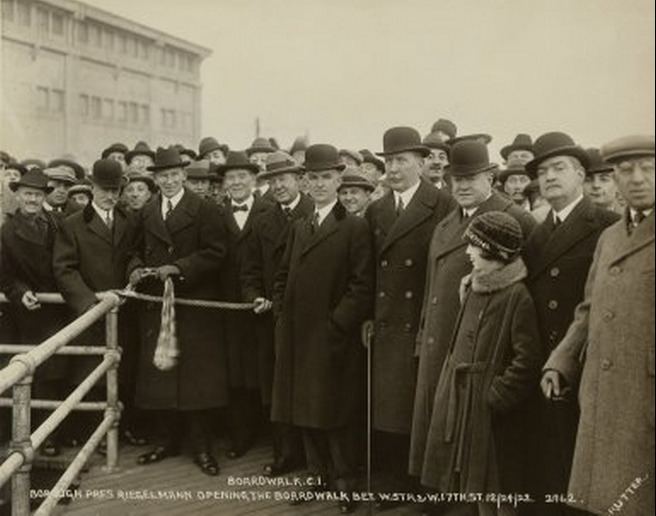Name Edward Riegelmann Role Politician | Died 1941 | |
 | ||
Edward J. Riegelmann (September 5, 1869 – January 15, 1941) was an American Democratic politician from Brooklyn, Kings County, New York, best remembered for the Riegelmann Boardwalk.
Contents

Biography

Riegelmann was one of five children born to Frederick and Margret Riegelmann on the Lower East Side of Manhattan. The family moved to Williamsburg, Brooklyn ten years later. Riegelemann graduated from the Metropolis Law School, which has since merged with the New York University Law School. He was admitted to the New York State Bar in 1898. He began practicing law with the Charles O. Grim and set out to make a mark in the field of Democratic Politics.
In 1904, Riegelmann was rewarded with leadership of the Democratic State Speakers Bureau in the presidential campaign. He then served as counsel to the Sheriff of Kings County, New York, assistant corporation counsel in Brooklyn, assistant counsel to the New York Public Service Commission, and was Sheriff of Kings County from 1915 to 1917. He was a delegate to Democratic National Convention from New York in 1920. He then ran successfully for Brooklyn Borough President, serving from January 1, 1918 to December 31, 1924. During his tenure as borough president, Rieglemann won approval for construction of the Brooklyn Municipal Building at Court and Joralemon Streets, worked to beautify Coney Island and make all access to the beach free, and was largely responsible for the construction of the Coney Island boardwalk, which was eventually named for him. He was a Democratic National Committee alternate in 1924 and 1940, and was appointed Justice of New York Supreme Court 2nd District, by Franklin Roosevelt serving from January 1, 1925 until he retired on December 31, 1939.
Edward J. Riegelmann died on January 15, 1941 in Brooklyn, aged 72, and was buried at Calvary Cemetery in Queens.
Riegelmann Boardwalk/Coney Island Beach
Almost a century before the boardwalk opened along the Atlantic Ocean, Coney Island was on its way to becoming the nation’s most popular pleasure ground. In 1824 the Coney Island House was established as a seaside resort, and within a few decades it was attracting a steady stream of visitors, including celebrities. After the Civil War, new railroad lines provided direct public transportation to a rapidly expanding list of attractions: restaurants, hotels, bathing pavilions, shops, amusement rides, race tracks, theatres, and as always, the beach and the ocean. At the turn of the century, amusement parks—Sea Lion Park, Steeplechase Park, Luna Park, and Dreamland—offered rides, concessions and entertainment on a spectacular scale.
Once the BMT subway line reached the area in 1920, the pleasures of Coney Island were just a five-cent ride away from the steaming city. Attendance on a hot summer day could reach as high as a million, causing extreme congestion on the beach. Making matters worse, private concessions (such as beachfront hotels, bath houses, and cabarets) controlled large portions of the beach. As Brooklyn Borough President from 1918 to 1924, Edward Riegelmann (1869–1941) took charge of beautifying Coney Island and ensuring public access to the beach and shore. After the city secured title to property along the beachfront, the $3 million beach improvement and boardwalk construction began in 1921.
The immense engineering project required 1.7 million cubic yards (1,300,000 m3) of sand to add another 2.5 million square feet (160,000 m2) to the beach area. Construction of the boardwalk made use of 120,000 tons of stone, 7,700 cubic yards (5,900 m3) of reinforced concrete, and 3.6 million feet of timber, including long leaf yellow pine for the flooring. From a height of 14 feet (4.3 m) above the beach, the 80-foot-wide (24 m) boardwalk stretched from W. 37th Street to Ocean Parkway and provided easy access to both beach and concessions. "Coney Island's Fifth Avenue" opened with great fanfare on May 15, 1923.
Even during the Great Depression, the promise of fun at Coney Island continued to draw millions of visitors. New York City Parks Commissioner Robert Moses, however, wanted to replace the commercial amusements with better opportunities for "exercise and healthy outdoor recreation." Parks was awarded jurisdiction of the beach and boardwalk in 1938, and Coney Island was given a $3 million facelift. Between 1938-41, Parks shifted and straightened out much of the boardwalk and extended it east to Brighton Beach. The beach was greatly expanded and entirely resurfaced with a 2-foot (0.61 m) layer of fine white sand. The boardwalk was named for Borough President Riegelmann. Since 1983 the boardwalk has hosted the annual Mermaid Parade, which welcomes the summer beach season with a wild procession of sea-people.
In 1993 "The First Symphony of the Sea", a 300-foot-long (91 m) sculpture wall by artist Toshio Sasaki, was installed on the boardwalk outside the Aquarium for Wildlife Conservation. Riegelmann Boardwalk has been reconstructed numerous times since 1923, and many portions are now made of sturdy hardwoods such as Lophira alata, Tabebuia serratifolia, and Dipteryx odorata. Along a distance of 2.7 miles (4.3 km), eastward from West 37th Street to Corbin Place, at the end of Brighton Beach, there are 1.3 million boards and 15.6 million screws and nails (about 12 to a board).
